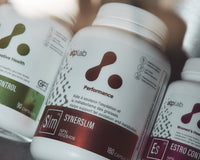4 ways to optimize digestion, improve health, & maximize bioavailability of nutrients

Written by Dwayne N. Jackson, PhD
Bioavailability has become a “scientific buzzword” in the supplement industry, often used to highlight a product’s superior absorption into the bloodstream. Similarly, digestion is the process of mechanically and enzymatically breaking down food into substances for absorption into the bloodstream.
So, products that make the general claim they have “high bioavailability” are simply saying that the product has been optimized in the lab for absorption. However, when we are considering the bioavailability of nutrients from food and supplements that we consume, we must recognize that bioavailability can only be maximized if digestion is optimized.
Defects in any aspect of digestion can result in uncomfortable gastrointestinal symptoms and the inability to absorb certain nutrients.
Digestion is a form of catabolism or breaking down of substances that involves two separate processes:
- Mechanical digestion: physically breaking down food substances into smaller particles to undergo chemical digestion more efficiently.
- Chemical digestion: which further degrades the molecular structure of the ingested compounds by digestive enzymes into a form that is absorbable into the bloodstream.
Defects in either mechanical digestion or chemical digestion can lead to nutritional deficiencies and gastrointestinal pathologies.
Through the gastrointestinal system, micronutrients (minerals and vitamins) and fluids, enter the body. Macronutrients (fats, proteins, and complex carbohydrates) are broken down into small and absorbable units (digested), principally in the small intestine. The products of digestion, including vitamins, minerals, and water, cross the intestinal mucosa and enter the lymph or the blood (absorption).
Our gastrointestinal system is a collaborative set of organs that run from the mouth to the anus. Which includes:
- Oral cavity
- Stomach
- Liver
- Gallbladder
- Pancreas
- Large & Small intestine

Here are 4 ways to optimize digestion and get the most out of your nutrition:
- OPTIMIZE YOUR ENZYMES
Digestion of macronutrients (i.e., carbs, protein, and fat) is a systematic process coordinating the action of many digestive enzymes. Enzymes from the salivary (and lingual glands) breakdown carbohydrates and fats, enzymes from the stomach digest proteins, and enzymes from the pancreas digest carbohydrates, proteins, lipids, RNA, and DNA.
Other enzymes that help in the digestive process are found in the luminal membranes and the cytoplasm of the cells that line the small intestine. The action of the enzymes is promoted by the hydrochloric acid (HCl), which is secreted by the stomach, and bile from the liver.
Hydrochloric acid secreted by the parietal cells serves three main functions:
1) To create a hostile environment for pathogenic microorganisms consumed through the mouth
2) To denature proteins and make them more accessible for enzymatic degradation by pepsin
3) To activate the zymogen pepsinogen to its active form, pepsin. Epithelial cells of the gut also secrete a substance called intrinsic factor, necessary for the absorption of Vitamin B12 in the terminal ileum.
Many people experience enzymatic dysregulation due to genetics, aging, and poor gut health. If you notice that certain foods or large meals give you digestive issues, like gas, bloating, or poor bowl movements, and you have no known food allergies, then you will likely benefit from using an enzyme and HCL optimizing supplement like ATP Lab's Enzymatik Control.
Enzymatik Control contains a natural array of all the enzymes needed to breakdown an assimilate carbohydrates, fats, and proteins into the blood stream. Furthermore, it is formulated with 400 mg of Betaine HCL per capsule, which rapidly and acutely promotes gastric re-acidification. The end-result is better digestion, reduced gas and bloating, and better assimilation of nutrients.
Take 1-2 capsules ATP Enzymatik Control mid-meal with each of your largest meals throughout the day.
2) GIVE LIFE TO YOUR LIVER
The liver plays a role in nearly every organ system in the body. It links the endocrine and gastrointestinal systems by aiding in digestion and metabolism.
Here are 4 important liver functions that ultimately dictate the bioavailability of nutrients you ingest:
- Bile for bioavailability: Your liver continually produces bile, a necessary component of the digestive process. Bile helps convert ingested fats into energy that your body uses. Your liver also creates albumin, a blood protein that carry’s hormones, drugs, and fatty acids throughout your body.
- Toxic waste removal: When you take in a potentially toxic substance, like alcohol or medicine, your liver helps alter it and remove it from your body.
- Seek and Destroy: When bacteria, viruses, and other harmful organisms enter your body, your liver can find and destroy them. This is done by specialized cells in your liver.
- Blood glucose bioavailability: Beyond blood detoxification, one of the liver's many jobs is regulating blood sugar, but fat in the liver makes that organ less responsive to insulin. Insulin insensitivity results in hyperglycemia (too much glucose in the blood), which can lead to type 2 diabetes. This hormonal insensitivity limits the bioavailability of glucose to cells that need it, resulting in lethargy, exercise intolerance, excess weight gain, and serious health consequences.

Keep your liver happy by abstaining from illicit drugs and alcohol, following a healthy natural diet (free from processed and chemical foods), maintaining a healthy level of body fat, exercising regularly, and using a liver support supplement like ATP Lab's Hepatik Defense.
Hepatik Defense contains several science-backed ingredients proven to support and recover liver function. Take 1 capsule, 3x daily with your largest meals containing protein.
3) GET A GRIP ON GLUCOSE
Your blood sugar level rises immediately after eating a meal or snack. In a healthy person, insulin then starts working, and the blood sugar level returns to the pre-meal level about 2 hours after eating.
If recent blood work is showing that your fasting blood glucose is creeping up (due to inactivity, poor diet, alcohol use, etc.) or if you plan on eating an abundance of carbohydrates over a short or long period of time (e.g., cheat meals, holidays, carbohydrate loading, etc)—you may want to consider the following:
- Exercise daily: Shoot to get 10,000 steps in, resistance train, endurance train, or just move. 30-60 minutes of physical activity daily will keep your insulin sensitivity high and blood glucose normalized.
- Eat well: A diet high in fibre, protein, healthy fats, and loaded with vegetables will do wonders for your glucose bioavailability. Just make sure to stay away from refined sugars.
- Use a glucose disposal supplement: Glucose disposal agents are supplements that improve glucose bioavailability to our cells. They do this by promoting glucose uptake from the blood to skeletal muscle where it can be used immediately to fuel activity or can be stored in our resting muscles and liver as glycogen, to provide a carbohydrate source when needed (e.g., during prolonged physical activity, fasting, etc). Glucose disposal agents, mainly work by mimicking insulin’s actions and/or increasing insulin sensitivity.
If you are currently dealing with elevated blood glucose, eat high carbohydrate meals, or just want to maximize carbohydrate bioavailability, I suggest using a pharma-grade glucose disposal agent like ATP Lab’s Gluco Control. Use 2 capsules, 2x times daily with your biggest meals.
4) PROTECT YOUR GUTS WITH PRE- & PRO-BIOTICS
Gut health is the key to assimilation and maximizing bioavailability of nutrients. However, many people suffer from dysbiosis, a condition in which the gut bacteria becomes imbalanced, leading to a wide range of digestive disturbances including bloating, mucus in stool, solid food in stool, diarrhea, constipation, and stomach cramps. Dysbiosis can occur with a poor diet, alcohol use, or if you are using antibiotics, NSAIDs (Advil, Naproxen, etc), or proton pump inhibitors (e.g., PPIs like Prilosec, Prevacid, Nexium, etc)
If you are experiencing any of the above symptoms or are using antibiotics, NSAIDs or PPIs, then it might be time to consider increasing the probiotics and prebiotics in your diet.
Probiotics are forms of healthy bacteria that colonize in the gut to rebalance the gut microbiota and increase gut health. You can find beneficial probiotic bacteria in fermented foods like sauerkraut, kimchi, kefir, yogurt, kombucha, pickles, etc.
In terms of probiotic supplements, look for products that have a focus on science-backed strains of Lactobacillus and Bifidobacterium. For this, I highly recommend ATP Lab's, Probio7. Each capsule of Probio7 contains 50 billion active bacteria (guaranteed) from 7 different forms of Lactobacilli and Bifidobacteria.
For reestablishment of gut microbiota take 1-2 capsules daily for 1-2 months with a diet high in prebiotic fibre. If you are taking antibiotics, use 1-2 capsules in the morning and 1-2 capsules at night with food containing prebiotic fibre.
What are prebiotics?
Prebiotics are a group of nutrients that are degraded by gut microbiota. They are nondigestible compounds that, through metabolization by microorganisms in the gut, beneficially modulate composition and/or activity of the gut microbiota. In simpler terms, prebiotics support the growth and colonization of healthy probiotic bacteria which supports healthy digestion and increased bioavailability of nutrients.
Prebiotics promote:
- Increases in Bifidobacteria and Lactobacilli
- Production of beneficial metabolites
- Increases in calcium absorption
- Decreases in protein fermentation
- Decreases in pathogenic bacteria populations
- Decreases in allergy risk
- Effects on gut barrier permeability
- Improved immune system defense
Prebiotic fermentable fibres include fructans (e.g., inulin), galacto-oligosaccharides (e.g., blueberries), starch and glucose-derived oligosaccharides (e.g., resistant starch from green banana), and flavanols (e.g., cacao).
To maintain a healthy gut microbiota, each day you should strive to get 30 g of high-quality fibre from an array of different sources-- a tough metric to hit for most people. The best way to assure you are consuming enough prebiotic fibre is to use a prebiotic supplement like ATP Lab's PreBioFib, 2 times daily. Each scoop contains close to 10 g of prebiotics, which have been formulated to synergize with ATP Lab's Probio7. For best results mix 1 scoop in 200-300 ml water and take with your dose of Probio7.





